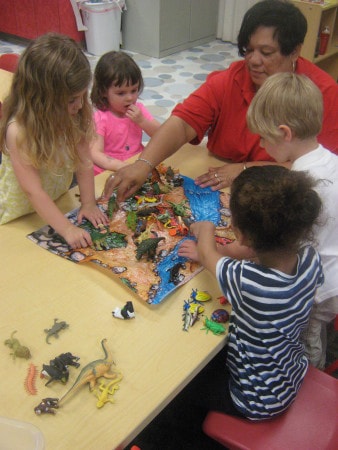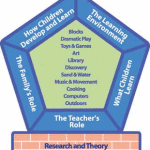 Just as we have designed our child development center facility with features based on what research says children need in order to learn and flourish, our curriculum is based on accepted scientific knowledge and evidence-based research. The foundation of our programs is centered on Creative Curriculum®, a comprehensive, integrated approach to curriculum and assessment. Creative Curriculum® takes new research and theory from the field of early childhood education and consolidates it into an easy-to-use approach to working with children and their families.
Just as we have designed our child development center facility with features based on what research says children need in order to learn and flourish, our curriculum is based on accepted scientific knowledge and evidence-based research. The foundation of our programs is centered on Creative Curriculum®, a comprehensive, integrated approach to curriculum and assessment. Creative Curriculum® takes new research and theory from the field of early childhood education and consolidates it into an easy-to-use approach to working with children and their families.
What is a comprehensive approach to curriculum?
Comprehensive approaches are based on the understanding of the complex social/emotional, physical, and cognitive development of young children and the way they learn. Guidance is given on the many factors that lead to a high-quality program for early childhood development. The framework also stresses the ongoing cycle of observing-guiding-assessing. The assessment system allows our teachers to respond to the individual needs and learning styles of each child.
The framework of the curriculum has five elements: The Family’s Role, the Teacher’s Role, How Children Develop, the Learning Environment, and What Children Learn. Each of these elements correlates with the areas of interest: blocks, dramatic play, toys & games, art, library, discovery, sand and water, music and movement, cooking, computers, and outdoors.
The Family’s Role
Home and school are a young child’s two most important worlds, and the child must bridge these two worlds every day. It is of the utmost importance for home and school to be connected in positive and respectful ways so that the children feel a sense of security and safety.
The owners and staff at The Learning Connection are devoted to getting to know each family and making everyone feel welcome, clearly communicating with families, and making the family a true partner in the child’s learning process.
The Teacher’s Role
Our teachers are engaged in the ongoing cycle of observing, guiding learning, and assessing children’s progress. Because children have unique learning styles and needs, our teachers use the concepts of both child-initiated learning and teacher-directed learning as well as large-group and small-group instruction.
The National Research Council report, Eager to Learn: Educating Our Preschoolers (2001), clearly documents the benefits of a wide range of teaching strategies.
How Children Learn
 Understanding how children learn is vital to implementing a successful program. Creative Curriculum® recognizes that there are three parts to how children develop and learn:
Understanding how children learn is vital to implementing a successful program. Creative Curriculum® recognizes that there are three parts to how children develop and learn:
- What children are like socially/emotionally, physically, cognitively, and in language development
- Individual differences and variations in gender, temperament, interests, learning styles, and life experiences
- Using a developmental continuum tool to assess children’s development and guide teachers’ planning
The Learning Environment
The classroom space is organized into eleven areas of interest: blocks, dramatic play, toys & games, art, library, discovery, sand and water, music and movement, cooking, computers, and outdoors. Interest areas offer numerous opportunities for children to explore, discover, and grow. Our teachers also build a classroom community where children feel that they are part of a larger society in which they use social skills, conflict resolution, and learn constructive behavior.
What Children Learn
The content of Creative Curriculum® is based on published standards that relate directly to the subject area curricula used in elementary schools. Our teachers develop lesson plans that are in alignment with Virginia’s Foundation Blocks for Early Learning. The curriculum content is based on seven content areas that correlate to each of the eleven areas of interest. The content areas are:
- Literacy – vocabulary and language, phonological awareness, letters, words, print, comprehension, and books
- Mathematics – numbers, patterns and relationships, geometry and special awareness, measurement and data collection, organization, and representation
- Science – the physical properties of objects, living things, the earth, and the environment
- Social Studies – how people live, work, and get along with others
- The Arts – dance, music, dramatic play, drawing, and painting
- Technology – tools and their basic operations and uses
- Process Skills – observing and exploring, problem solving, organizing, and communicating
Interested in learning more about Creative Curriculum® and how we put it into action in our everyday? Contact us today.

